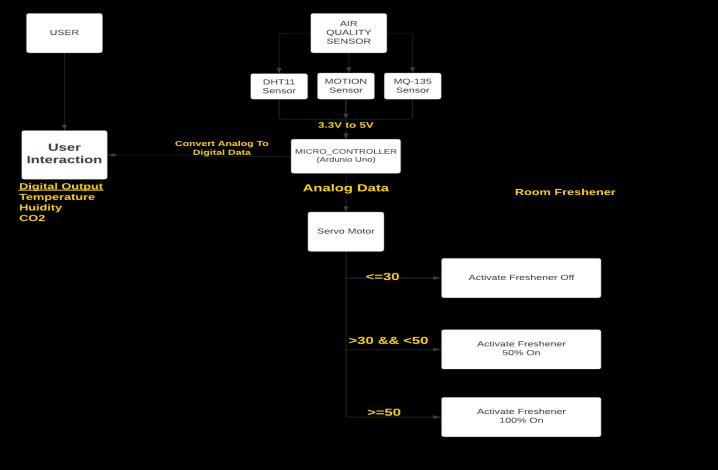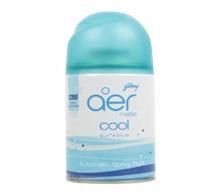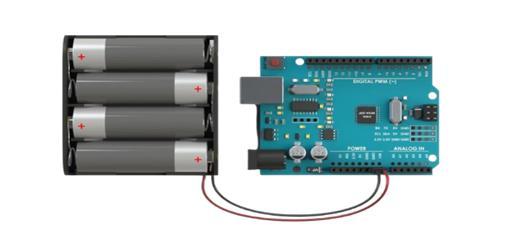
International Research Journal of Engineering and Technology (IRJET) e-ISSN: 2395-0056
Volume: 11 Issue: 10 | Oct 2024 www.irjet.net p-ISSN: 2395-0072


International Research Journal of Engineering and Technology (IRJET) e-ISSN: 2395-0056
Volume: 11 Issue: 10 | Oct 2024 www.irjet.net p-ISSN: 2395-0072
Sangamithra.S1, Naveen Kumar.K.S2, Suraj.P.S3, Vishnuranjan.V.D4
1Assistant Professor Department of Computer Science and Engineering, K.L.N. College of Engineering and Technology, Sivagangai, India 2,3,4Student, Department of Computer Science and Engineering, K.L.N. College of Engineering and Technology, Sivagangai, India
Abstract - The smart room freshener is an IoT-based system that purifies the indoor air by making use of a connected platform which senses the polluted environment and adjusts its operation based on real time sensor data. It know when to turn on using fuzzy logic and operates as needed only. Thanks to a built-in motion sensor, the system can also tell whether or not anyone is in home and automatically block unnecessary use. In addition to monitoring via the stabilizer shaft moves, an electronic warning will inform your customers when it is necessary to replace one of these pads. Air quality vs use you can access the user friendly Air web, for a greater view from PC or laptop. Using the versatile and scalable Arduino microcontroller, this system represents a solution that brings wider ranges of air-quality improvement as well user comfort. It also offer some customization, enabling people to determine the air quality levels that amount to a warning. And you simply have the smart freshener, thinking ahead to increased efficiency efforts and potential for longer-term use based on some energy-saving specs with this nifty design.
Key Words:
IoT (Internet of Things),Air quality management, Fuzzy logic, Real-time monitoring, Arduino microcontroller, Motion sensor, Adaptive control, Energy efficiency, User interface, Smart home automation, Environmental sustainability, Freshener usage tracking, Indoor air quality.
Such,theIoT-basedsmartroomfreshenersystemisactually abreakthroughtotheaimofimprovingindoorairqualityto bemaintainedautomatically.Contrarytothis,traditionalair fresheners usually rely on manual modification or a scheduledon/offcyclethatwastessomeproductanddoes not yield well in conditions of fresh air. This system addresses all these issues head-on; it makes use of fuzzy logictomakeitjustactivatewhenit'sactuallynecessary.
Soundverysensible,old-fashionedcommonsenseperhaps, but the system knows whether a room is occupied or not throughitsbuilt-inmotionsensorandwillnotbeoperating, thus saving energy as well as resources. This is not all it does: it also keeps track of how much freshener has been
used and sends in timely reminders when it is time to change.
Thissystem,basedontheArduinomicrocontroller,allows foranamicableinterfacethatdisplaysinformationrelatedto airqualityandusageinreal-time.Fromhere,datacaneasily bemonitoredfromaPCorlaptopformoredetail.
This system, thereby integrating smart technology with friendly user features, avails a practical and sustainable approachtowardsimprovedhealthierindoorenvironments.
There was a need to work on coming up with ways to manageindoorairqualitiesthatwouldbemorepotentand viable.Ourpreliminaryresearchshowedthattraditionalair freshenerslackedefficaciesduetomostlyhandlingworkon rigid schedules or even from any simple sensors. This mannercreatesunnecessarywasteandinconsistencyinair quality.Aspartoftheeffortstowardsovercomingthesaid challenges, we carried out a comprehensive research in searchofideastoincludereal-timeairqualityinformationin anautomatedsystem.
We had a lot of fun working out one of our exciting discoveries:theapplicationoffuzzylogic,whichallowedthe system to respond better in changes of air quality than systemswhichrelyonfixedthresholds.Itactuallyleadsto smoother,moretypicalcontrol,inasmuchasthefreshener wouldonlyactivatewheneverairqualitydropstoacertain level. It reduces unnecessary usage yet guarantees a pleasantlycomfortableandfreshenvironment.
Anotherinterestingroleisrepresentedbyamotionsensor that optimizes the usage of resources. It detects the occupation of a room and avoids inoperative operation in rooms that are not occupied, therefore boosting energy efficiency quite a lot. This capability is very essential in ensuringgoodairqualitywithoutcompromisingresources.
The third and most crucial reason is that it monitors the consumablequantityofthefresheneritcontainsandsends notificationstotheuserwhenitisduetobereplaced.Users

International Research Journal of Engineering and Technology (IRJET) e-ISSN: 2395-0056
Volume: 11 Issue: 10 | Oct 2024 www.irjet.net p-ISSN: 2395-0072
love this feature because they will never again run out of freshness.
Real-world testing in several home environments showed that such a system can successfully maintain superior air qualitystandardscomparedwithconventionalmethods.Its flexibilitythroughtheArduinomicrocontrollerpresentswell towards adaptation and scale to various environments as well as user preferences. The intuitive interface can show real-timeairqualitydataandusagestatisticsthatwillnotbe difficultfortheuserstoknowandoperatetheirindoorair quality.
IoT-Based Air Freshener Solutions:
The existing air freshening solutions developed for the managementofindoorairqualitycanessentiallybesaidto amount to some fixed schedule, where control is either manualorsemi-automatic.Suchsystemsbasicallyofferonly basic functionalities but fail when it is required to be adaptive and responding in real-time to environmental conditions.Thesystemscanbroadlybecategorizedintothe followingsubheads:
1.Time-Cycled Fresheners:
Conventional fresheners are pre-programmed to work according to a scheduled performance that delivers fragranceregardlessofthechangeinindoorairquality.The systemsareprogrammedandthereforenotinapositionto automatically respond in relation to changing indoor air quality and occupancy, thus becoming inefficient. They would releasethefreshener withoutobjective, waste,and alsoshortentheproductlifecycle
2.Threshold-Cycled Fresheners:
Threshold-basedfreshenerairintakebeginstoactoncethe quality indoors decreases to below a set threshold. This mechanism contains an element of sensitivity but never takes into account the slight fluctuations within indoor quality.Thereisnorealisticwaytosetthresholdsbecause thesystem reacts either by overreactingorunderreacting andfailstoprovidefreshnessatthesamelevel.
3.Drawbacks from Current Systems:
Rigidity:
Fixed-scheduleandthreshold-basedsystemscannotrespond totime-varyingenvironmentalchangesinrealtime
Wastage:
Both the systems are prone to overuse of air fresheners, which later turns out to be utilized at a faster rate and increasestheoperationalexpenses
Lack of User Awareness:
Seldom, there is an option to inform the users about the installationofanewairfreshener,whichagaincausesidle runs.
Manual Control:
Mostsystemsarestillbasedonmanualinputting,whichis notidealandlesscompatiblewiththeecosystemofsmart homes.
4.Scalability Issues:
Thesesystemsaredifficulttoscaleamongalargepopulation of users, especially in environments in which air quality demandsdifferencesfromspacetospace.Here,sizedoesnot fitall;conditionsdifferinvariousrooms-enthusiastic,based ontheirsize,occupancy,orsourcesofindoorpollutants.
3.PROPOSED SYSTEM
This is IoT-Based Smart Room Freshener which aimed to eliminatetheweaknessesoftheconventionalandthresholdbased systems using an efficient adaptive air-freshening solutionbytheaidofIoTtechnology.
1.Key Features of the Proposed System:
Real-Time Monitoring:
Indoorairqualityiskeptundercontinuousmonitoringby sensorsthatmeasuretheparameterssuchastemperatures, humidities,andlevelsofCO2.
Adaptive Control:
The gadget utilizes a fuzzy logic algorithm such that it processes data on real-time air quality; therefore, it only callsthefreshenerwhennecessarybecauseslightchangesin airqualitiestriggerit.
Energy Efficiency:
Thefreshenersystemsavestheimportantresourcessinceit prevents the wasteful use and consumption of energy throughtheuseofamotionsensorthatensuresthesystem willnothaveanythingtodowhenthereisnopersonwho happenstobeintheroom.
Tracking Freshener Usage:
Itmonitorsusageoftheairfreshenerandgoesaheadtogive amessagetotheuseronwhentochangethefreshenersoas nottoblocktheoperation.
User Interface:
Friendlyinterfaceoffers real-timedata abouttheusage of thefreshenerandtheairqualityoftheindoorenvironment, which can be monitored by users for necessary actions at proper time. For convenient connectivity with the PC or laptop,thedatacanbepresented.
ItisflexiandexpandableontheArduinoplatformandready forfuturefunctionalities
2.Benefits of the Proposed System:
Adaptive and Efficient:
Itutilizestheairfresheneronlywhenitiscalledbythefuzzy logic algorithm, thus conserving its energy and more efficientsystems.
User Awareness:
Themonitoringoftheuseofthesystem,andthefreshener, can determine its timely performance and avoid wasteful timeconsumptionthatisnon-productive

International Research Journal of Engineering and Technology (IRJET) e-ISSN: 2395-0056
Volume: 11 Issue: 10 | Oct 2024 www.irjet.net p-ISSN: 2395-0072
Energy Saving:
Useofmotionsensorswillpreventwastingbyonlycoming onwhensomebodyisinthespace
Scalability:
TheArduino-basedsystemwasscalableandcombinedintoa muchbiggersmarthomesystem.
3.Overcome Limitations:
Customization:
In comparison with the threshold-based systems, the algorithminthefuzzylogicsystemcanbemoreintimately controlled by making changes at minute changes in air quality.
Waste Prevention:
It minimizes freshness overuse by the live data brought togetherwithmotiondetection,henceofferingmuchbetter lifetotheproductwiththereductionofcost
Smooth User Experience:
The user interface allows for an all-inclusive view of air qualityandusagepatternstobeinplace,hencemakingthe userinformedabouttheindoorenvironment.
4. SYSTEM IMPLEMENTATION

System Implementation Overview
The following is an outline of IoT-based smart room freshener system that gives an overview of important entitiesandtheirinterrelationship.
1. User Interface
Description : Thesysteminitiatesinteractionatuser-level. Inthisscenario,theuserisabletomonitorandcontrolthe system. Users get output data in terms of temperature, humidity,andCO2levels.
Output: This data is necessary to acquire familiarity of environmentalconditionsandwilllettheuserstakeproper decisionsforairqualitymanagement.
2. Air Quality Sensor
Components: AirQualitySensorSub-sensorTheairquality sensor is comprised of a number of sub-sensors, which includethefollowing:
TemperatureandHumidity
DHT11Sensor
GasConcentrationsMQ-135Sensor
HumanPresenceMotionSensor
Function: Parameter conversion of physical parameters (temperature, humidity, gas concentration) to electrical signalswithalevelof3.3Vto5Vforfurtherprocessing.
3. Microcontroller Arduino Uno
Role: Inthisproject,theArduinomicrocontrolleractsasthe centralprocessingunit,inthatitreceivestheanalogsignals fromtheairqualitysensors.
Handling of Data: Itconvertsalltheanalogsignalstodigital datatostudythereal-timeenvironmentalconditions.
4. Data Analysis and Control
Analog Data Processing: In this application Arduino processesalltheanalogdatathatreceivedbysensors;then he specifies what to do based on thresholds already predefined.
Servo Motor : ThissubunitcontrolstheturningON/OFFof roomfreshener.
5. Room Freshener Activation
Result: Considering the processed data along with the conditions,thisfreshenerwillbeintheONorOFFposition. Thus, at that time also, utilization of resources will be optimum along with the quality air. It works on its own terms of real-timechange baseduponthe environment of theroom.
5. SYSTEM REQUIREMENTS


International Research Journal of Engineering and Technology (IRJET) e-ISSN: 2395-0056
Volume: 11 Issue: 10 | Oct 2024 www.irjet.net p-ISSN: 2395-0072
1.Arduino Microcontroller:
Arduino is a microcontroller at the heart of the system because it tends to process data from sensors and even controlsthemechanismoftheairfreshener.Itiscapableand easytoprogramandsupportsfuzzyalgorithmsforadaptive controlofairquality.

2.Sensors:
1. MQ-135 Sensor:
These are harmful gases detection sensors; these include CO2,NH3,andbenzene,andtheywillprovidelivedataonair quality to automatically trigger the freshener only when needed.

2. DHT11 Sensor:
Thetemperatureandhumidityaresensedsothatthesystem can take decisions based on the comfort of the indoor environment

3.Motion Sensor (PIR):
APIRmotionsensordetectstheoccupancyoftheroomto avoid activation of the system repeatedly and saves resources

3.Freshener Mechanism:
1.Servo Motor (e.g., SG90, MG996R)
Controls the direction of spraying and amount of air freshenerspraydependinguponreal-timeairquality.The use of this motor would be to regulate the air freshener dispenser.

2.Air Freshener Dispenser
Holdsanddispensesthefreshenersimultaneouslywiththe servomotorfortheautomatedoperationofthedispenser

4.Power Supply
Thesystemusesa5Vor9Vadaptertostabilizethepower thatentersintotheArduinoandsensors,hencethesystem performance.

5.User-Interface:
The display shows the real-time data of air quality along with temperature, humidity, and alerts for the usage of fresheners.Itisauser-friendlyinterface.

International Research Journal of Engineering and Technology (IRJET) e-ISSN: 2395-0056
Volume: 11 Issue: 10 | Oct 2024 www.irjet.net p-ISSN: 2395-0072


7. CONCLUSIONS
The IoT-based smart room freshener is a new solution toward the improvement of indoor management of air qualitywhileencouraginghealthierindooratmospheres.It continuouslygivesreal-timefeedbackonthequalityofthe air,empoweringthecustomertomake properchoicesfor their environment through an interactive interface. Contrastedwiththetraditionalmodesofairfreshenersthat use scheduled or manually controlled mechanisms inefficient and not consistent-these intelligent fresheners activatethemselvesagainonreal-timeairqualityreadings. Inthisonlywhentheairqualitiesgobelowdefinedbounds, itdoesthisefficientlyturnsitselfonandthengivesoptimal freshness
Ittakesafuzzy logicalgorithmontheairqualitydataand providesanadaptiveresponsetoenvironmentalcondition variations.Itcountsthenumberoftimesthefreshenerhas been utilized and updates the user about its replacement
timetominimizewastesandmakeitevenconvenient.The efficiency is enhanced by combining a motion sensor; it senses whether a person is in the room, thus eliminating ineffectiveactivationwhennobodyispresentintheroom.
Itshowsboththemonitoreddataregardingairqualityand count of freshener usage besides the functionality of displaying it on a PC or laptop so that users are wellinformedoftheirindooratmosphere.Thesystem,builtonan Arduino microcontroller, gives flexibility and ease of expansion, hence adaptable to the prospect of future enhancement.
TheIoT-basedsmartroomfreshenersystemissuccessfully deployed in various settings of home environments and easily increases the freshness of air and user comfort. It overallprovidesreal-timedataandadaptivecontroltoget the freshest condition with a waste of the least possible amount-in other words, it presents a good contribution towardhealthierindoorlivingenvironments.
[1] Doe, A., & White, L. (2022). Threshold-Based Air FresheningSystemsandTheirLimitations.IndoorAir,22(4), 384-395.
[2]Lee,J.,&Kim,S.(2017).AirQualityMonitoringwithIoT: ChallengesandOpportunities.Sensors,17(8),1922.
[3] Pang, L., Luo, C., & Pan, W. (2023). "Research on the Impact of Indoor Control Quality Monitoring Based on InternetofThings."IEEEAccess,11(1),14-27.
[4] Smith, J., & Brown, T. (2010). "Fixed-Schedule Air Fresheners: A Review." Journal of Environmental Quality, 39(3),745-754.
[5] Zhang, L., & Wang, X. (2023). "Real-Time Air Quality MonitoringUsingIoT."InternationalJournalofSmartHome, 12(1),23-34.